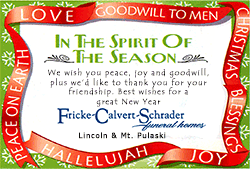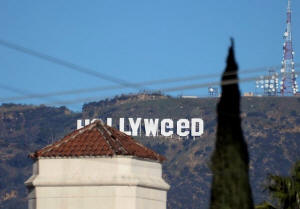|
'Hollyweed': Prankster alters LA's
landmark sign
 Send a link to a friend
Send a link to a friend
 [January 02, 2017]
LOS ANGELES (Reuters) - The iconic
hillside sign overlooking Southern California's film-and-television hub
was defaced overnight in honor of marijuana. [January 02, 2017]
LOS ANGELES (Reuters) - The iconic
hillside sign overlooking Southern California's film-and-television hub
was defaced overnight in honor of marijuana.
Residents awoke on Sunday to find "Hollyweed" staring down at them in
four-story, white letters from Los Angeles' Mount Lee, where a version
of the picture-ready "Hollywood" sign was first erected in 1923.
City surveillance cameras captured footage of someone dressed in black
about 3 a.m. (1100 GMT) whom police believe was behind the conversion,
Sgt. Robert Payan of the Los Angeles Police Department said in a phone
interview.
Material similar to a tarp was placed over the two O's to make them
appear as E's, and park rangers were assessing how to remove them, Payan
said.
There were no suspects, but the person if caught could be charged with
misdemeanor trespassing, he said.
A ballot measure to make recreational marijuana legal for adults was
easily approved by California voters on Nov. 8, opening the most
populous U.S. state to the burgeoning commercial cannabis market,
although the drug remains illegal under U.S. federal law.

Rapper Snoop Dogg, a noted cannabis consumer, tweeted a photo of the
sign on Sunday and said: "#hollyweed - that's were I get my mail.
#merryjane."
The Hollywood sign remains a popular spot for hikers and tourists, who
used to be able to walk up to the sign and take a picture. Now, a fence
blocks people, and accessing the sign is difficult.
[to top of second column] |

A view shows the "iconic "Hollywood" sign overlooking Southern
California's film-and-television hub, which was defaced overnight in
the Hollywood Hills in Los Angeles, California, U.S. January 1,
2017. REUTERS/Kevork Djansezian

The famed vista with the Hollywood sign was nearly spoiled by
development in 2010 until a conservation group, with donations from
Playboy magazine founder Hugh Hefner and others, purchased adjacent land
to save the view.
The sign originally read "Hollywoodland" and was created to promote
a housing development. The last several letters deteriorated in the
late 1940s, and the part that remained was restored in 1978.
(Reporting by Kevork Djansezian; Writing by David Ingram; Editing by
Mary Milliken and Phil Berlowitz)
[© 2017 Thomson Reuters. All rights
reserved.]
Copyright 2017 Reuters. All rights reserved. This material may not be published,
broadcast, rewritten or redistributed.
 |